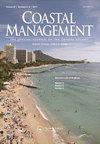海岸管理期刊海洋酸化专刊简介
IF 1.9
4区 环境科学与生态学
Q4 ENVIRONMENTAL SCIENCES
引用次数: 0
摘要
人为碳排放正在增加大气中的碳浓度。全球海洋每年吸收约四分之一的这些排放(Friedlingstein et al., 2020)。海水对碳的吸收引发了几种化学反应,包括碳酸的产生、碳酸钙离子可用性的降低和pH值的下降(Doney et al. 2009)。这种化学变化过程被称为海洋酸化(OA)。模型预测,在“一切照旧”的温室气体排放情景(RCP 8.5)下,到2100年,海洋的酸化程度可能会提高150% (Phillips et al. 2018及其中的参考文献)。与许多气候变化影响一样,OA正在发生并与许多其他压力因素相互作用,包括海洋变暖和脱氧,以及与气候无关的压力因素,如发展、栖息地退化和污染(IPCC 2019)。在沿海系统中,上升流、营养物负荷(被废水放大)、污染和淡水输入等过程会进一步加剧情况(Duarte et al. 2013及其中的参考文献)。OA的增加,加上这些多重压力源,对维持就业和支持沿海经济至关重要的海洋物种和生态系统构成了威胁(Jewett et al. 2020)。牡蛎幼虫特别容易受到腐蚀条件的影响,并且是酸化加剧的最早指标之一(Barton et al. 2012;2015)。世界各地的研究都在研究酸化对贝类的整个生命周期的影响,包括牡蛎、龙虾、螃蟹、虾和贻贝。此外,模拟酸化条件会导致幼年鲑鱼的嗅觉和行为变化(Williams et al. 2019),这表明OA可能会影响鳍鱼。翼足类动物是海洋食物网的组成部分之一,在酸化条件下显示出明显的外壳溶解迹象(Bednaršek et al. 2018)。而在2020年,研究证实了对具有经济价值的甲壳类野生种群的现有影响,发现OA正在导致西海岸邓杰内斯蟹的甲壳溶解和感觉器官损伤(Bednaršek et al. 2020)。在美国,NOAA越来越多地将注意力和资金集中在区域脆弱性评估上,研究对牡蛎、扇贝和人类社区的影响,这些社区对海洋变化风险最大的物种做出回应(NOAA 2017)。美国和世界各地的许多社区依靠沿海资源获取食物、维持健康、经济稳定的营养物质,并实践文化和土著传统。日益酸化的海水威胁到具有文化重要性的物种,并可能影响部落和第一民族社区的部落条约权利(Crosman et al. 2019)。一项研究估计,OA可能会给美国从北太平洋到加勒比地区的社区造成数十亿美元的损失(Jewett et al. 2020)。太平洋西北部的贝类产业估计贡献了270美元本文章由计算机程序翻译,如有差异,请以英文原文为准。
Introduction to Coastal Management Journal Special Issue on Ocean Acidification
Anthropogenic carbon emissions are increasing atmospheric carbon concentrations. Global oceans absorb about one-fourth of these emissions each year (Friedlingstein et al., 2020). Seawater’s carbon absorption initiates several chemical reactions, including the production of carbonic acid, reduction in the availability of calcium carbonate ion, and declining pH (Doney et al. 2009). This process of chemical changes is called ocean acidification (OA). Models predict that under a “business as usual” greenhouse gas emissions scenario (RCP 8.5), the ocean may become 150% more acidified by 2100 (Phillips et al. 2018 and references therein). As with many climate change impacts, OA is occurring and interacting with many other stressors including ocean warming and deoxygenation, and non-climate-related stressors like development, habitat degradation and pollution (IPCC 2019). In coastal systems, processes including upwelling, nutrient loading (magnified by wastewater), pollutions and freshwater inputs can further exacerbate conditions (Duarte et al. 2013 and references therein). Increasing OA, combined with these multiple stressors, threatens marine species and ecosystems that are essential for sustaining jobs and supporting coastal economies (Jewett et al. 2020). Oyster larvae are particularly vulnerable to corrosive conditions and were among the earliest indicators of increasing acidification (Barton et al. 2012; 2015). Studies across the world are examining acidification’s full lifecycle impacts on shellfish including oysters, lobster, crab, shrimp and mussels. Additionally, simulated acidified conditions cause olfactory and behavioral changes in juvenile salmon (Williams et al. 2019) suggesting that OA could impact finfish. Pteropods, one of the building blocks of marine food webs, show significant signs of shell dissolution under acidified conditions (Bednaršek et al. 2018). And in 2020, studies confirmed existing impacts to wild populations of economically valuable crustaceans, finding that OA was causing carapace dissolution and damage to sensory organs in West Coast Dungeness crabs (Bednaršek et al. 2020). In the U.S., NOAA has increasingly focused attention and funding on regional vulnerability assessments looking at impacts to oysters, scallops and human communities that reply on species that are most at risk from ocean change (NOAA 2017). Many communities in the U.S. and worldwide rely on coastal resources for food, nutrients that sustain health, economic stability, and practicing of cultural and indigenous traditions. Increasingly acidified waters threaten species of cultural importance and may impact Tribal Treaty Rights of Tribal and First Nation communities (Crosman et al. 2019). One study estimates that OA may contribute to billions of dollars in losses to communities in the U.S. from the North Pacific to the Caribbean (Jewett et al. 2020). The shellfish industry in the Pacific Northwest contributes an estimated $270
求助全文
通过发布文献求助,成功后即可免费获取论文全文。
去求助
来源期刊

Coastal Management
环境科学-环境科学
CiteScore
6.00
自引率
0.00%
发文量
24
审稿时长
>36 weeks
期刊介绍:
Coastal Management is an international peer-reviewed, applied research journal dedicated to exploring the technical, applied ecological, legal, political, social, and policy issues relating to the use of coastal and ocean resources and environments on a global scale. The journal presents timely information on management tools and techniques as well as recent findings from research and analysis that bear directly on management and policy. Findings must be grounded in the current peer reviewed literature and relevant studies. Articles must contain a clear and relevant management component. Preference is given to studies of interest to an international readership, but case studies are accepted if conclusions are derived from acceptable evaluative methods, reference to comparable cases, and related to peer reviewed studies.
 求助内容:
求助内容: 应助结果提醒方式:
应助结果提醒方式:


